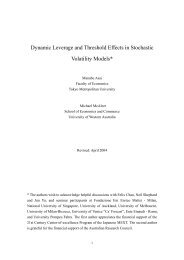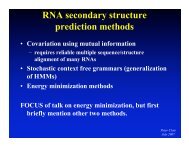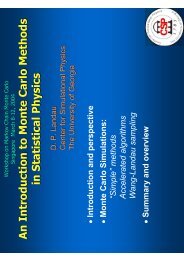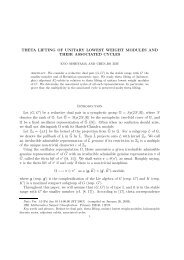Stein's method, Malliavin calculus and infinite-dimensional Gaussian
Stein's method, Malliavin calculus and infinite-dimensional Gaussian
Stein's method, Malliavin calculus and infinite-dimensional Gaussian
Create successful ePaper yourself
Turn your PDF publications into a flip-book with our unique Google optimized e-Paper software.
Lemma 8.1<br />
(i) Let W be a r<strong>and</strong>om variable. Then, W Law = N N (0; 1) if, <strong>and</strong> only if,<br />
E[f 0 (W ) W f(W )] = 0; (8.4)<br />
for every continuous <strong>and</strong> piecewise continuously di¤erentiable function f verifying the<br />
relation Ejf 0 (Z)j < 1.<br />
(ii) If g(x) = 1 ( 1;z] (x), z 2 R, then (8.3) admits a solution f which is bounded by p 2=4,<br />
piecewise continuously di¤erentiable <strong>and</strong> such that kf 0 k 1 1.<br />
(iii) If g is bounded by 1/2, then (8.3) admits a solution f which is bounded by p =2, Lebesgue<br />
a.e. di¤erentiable <strong>and</strong> such that kf 0 k 1 2.<br />
(iv) If g is absolutely continuous with bounded derivative, then (8.3) has a solution f which is<br />
twice di¤erentiable <strong>and</strong> such that kf 0 k 1 kg 0 k 1 <strong>and</strong> kf 00 k 1 2kg 0 k 1 .<br />
We also recall the relation:<br />
2d T V (X; Y ) = supfjE(u(X)) E(u(Y ))j : kuk 1 1g: (8.5)<br />
Note that point (ii) <strong>and</strong> (iii) (via (8.5)) imply the following bounds on the Kolmogorov <strong>and</strong> total<br />
variation distance between Z <strong>and</strong> an arbitrary r<strong>and</strong>om variable Y :<br />
d Kol (Y; Z) sup<br />
f2F Kol<br />
jE(f 0 (Y ) Y f(Y ))j (8.6)<br />
d T V (Y; Z) sup<br />
f2F T V<br />
jE(f 0 (Y ) Y f(Y ))j (8.7)<br />
where F Kol <strong>and</strong> F T V are, respectively, the class of piecewise continuously di¤erentiable functions<br />
that are bounded by p 2=4 <strong>and</strong> such that their derivative is bounded by 1, <strong>and</strong> the class of<br />
piecewise continuously di¤erentiable functions that are bounded by p =2 <strong>and</strong> such that their<br />
derivative is bounded by 2.<br />
Analogously, by using (v) along with the relation khk L = kh 0 k 1 , one obtains<br />
d W (Y; Z) sup<br />
f2F W<br />
jE(f 0 (Y ) Y f(Y ))j; (8.8)<br />
where F W is the class of twice di¤erentiable functions, whose …rst derivative is bounded by 1<br />
<strong>and</strong> whose second derivative is bounded by 2.<br />
Centered Gamma distribution. Let F () be as in (8.2). Consider a real-valued function<br />
g : R ! R such that the expectation E[g(F ())] exists. The Stein equation associated with g<br />
<strong>and</strong> F () is:<br />
g(x) E[g(F ())] = 2(x + )f 0 (x) xf(x); x 2 ( ; +1): (8.9)<br />
The following statement collects some slight variations around results proved by Stein [89],<br />
Diaconis <strong>and</strong> Zabell [20], Luk [40], Schoutens [85] <strong>and</strong> Pickett [94]. See also [80]. It is the<br />
“Gamma counterpart”of Lemma 8.1.<br />
39
















